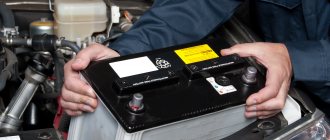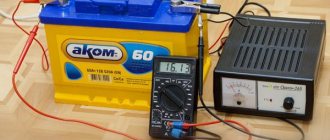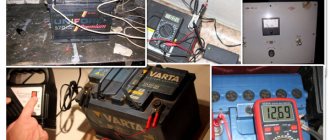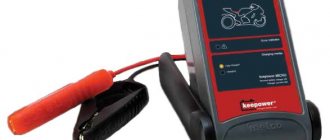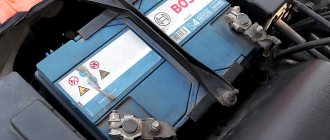About the Wheelbarrow ⁄ Maintenance and repair ⁄
After purchasing a new battery for a car, the owner has many questions regarding charging time and operating conditions. In some cases, car enthusiasts do not know how to prepare an electric current source for operation and whether there is any need for such an event at all. In this article we will talk about whether a new car battery needs to be charged, how long it takes to fully charge, and give operating recommendations that will help extend the life of the battery.
Does a new car battery need to be charged?
Experts agree that even a new battery must be charged. In most cases, the battery remains in the warehouse of the manufacturer or seller for a long time, which leads to a natural decrease in its capacity. In order not to make a mistake, it is better to check with the seller the date of manufacture of the battery and, based on the information received, decide whether to charge the battery or not.
There is an opinion that modern battery production technologies make it possible to minimize self-discharge. This statement is only relevant if the storage conditions in the warehouse are met. The following factors can affect the degree of self-discharge:
- room air temperature (norm 5-20 0C);
- air humidity;
- presence or absence of dust and dirt.
If the first parameter is more or less observed in warehouses, then few people monitor air humidity and dust. As a result, after 2 months the loss of battery capacity can reach 20-40%.
As you can see, the question of whether to charge a new battery or not disappears. It’s better to play it safe and charge, even if the seller swears that the product is fresh from the factory.
Rules for charging a maintenance-free battery
If everything is clear with the charge cycle of a serviced battery, then there are still unmaintained batteries that also require periodic attention.
After connecting the charger terminals to the battery terminals, turn on the device and set the current to 2 A. Every 15 minutes you need to come up and listen to the state of the electrolyte in the battery case. At the slightest sign of boiling, reduce the charging current, but do not turn off the charger completely.
If an unmaintained battery boils, it may rupture. In this case, many mechanics say that the battery has died. Don't be too zealous with the charger's amperage. For batteries of this type, a 4-hour charge is sufficient. The indicator installed on the body of many batteries greatly simplifies the process.
How to charge a new car battery correctly?
In fact, there are almost no differences between charging a new and used battery - both elements must be prepared in advance. But there are differences between the charge duration of a maintained battery and an unattended one.
In each case, a certain voltage supply method is used, which determines how long you need to charge a new car battery.
AC charging
It is advisable to use this method to charge a new serviced battery. This technique allows you to slightly reduce the degree of “boiling” of the electrolyte, which has a positive effect on the operation of the battery in the future.
It is advisable to charge a new car battery.
If you decide to charge the battery this way, use the instructions.
- Remove the battery from the car, make sure that the electrolyte temperature does not exceed 35 0C.
- Install the charger rheostat so that a voltage of 10% of the battery capacity is applied to the terminals.
- Wait for bubbles to appear in the electrolyte, measure the voltage at the contacts.
- If a value of 14.4 V is obtained, reduce the supplied current by 2 times.
- Check the voltage periodically; once it reaches 16 V and does not drop for three hours, the battery is charged.
It is difficult to say with accuracy how long it will take to charge. This procedure usually takes up to 14 hours. Therefore, do not forget to check the voltage in order to turn off the charger in time.
There is another way you can make sure that the battery is charged. Check the density of the electrolyte with a hydrometer. If it does not increase within three hours, the process is completed.
Be careful! If during the charging process you find that the battery temperature has risen to 45 0C or higher, turn off the charger or reduce the supplied current by 50%.
Constant voltage charging
This method is best used to charge a new, maintenance-free battery. The difference from the previous method is a constant supply of voltage without changing the current. This approach makes it possible to reduce the heating of the electrolyte.
For charging, a modern charger is used, equipped with a charge indicator and an automatic relay that regulates the supplied voltage depending on the parameters of the battery electrolyte.
Just an hour after connecting the charger, the battery capacity will rise to half, and after 4 hours – to 95% of that declared by the manufacturer. There is no need to guess how long it will take to fully charge. This takes about 5 hours, after which the full charge indicator on the charger will turn on.
Preparation for use
If you were unable to purchase a power unit that is completely ready for operation, you will have to bring it to the required performance yourself. Here is a list of what to do with a new car battery:
- unscrew the plugs from the holes for filling electrolyte, remove the sealing discs, if any;
- check and clean the ventilation ducts if necessary;
- make an electrolyte with a density of 1.28 t/m3 from battery sulfuric acid and purified water or buy it ready-made;
- pour the solution in a small stream to a level of 10–15 mm above the electrodes or touching the lower mark of the neck tube;
- repeat the density measurement after 2 hours - if the decrease is less than 0.02 t/m3, the battery is ready for installation.
If you do not get the desired result, you will have to connect the battery to a charger (ROM) : the battery terminals are connected to the same terminals of the device - positive to positive, and negative pole to negative. The initial temperature of the electrolyte is 15–25ºС; when heated to 45 degrees or higher, the charging process is stopped.
To ensure long-term operation of a new car battery, a control and training cycle is carried out - discharge the battery and then restore its potential again. The voltage is reduced to 10.3 volts within 10 hours using the same ROM and immediately switched to charging, which lasts half a day.
Operating a new car battery
To avoid having to go to the auto shop again in a year, you need to know how to prepare the battery for use and use it in the future. For those who have a vague idea of what to do with a new battery, we have prepared two instructions.
First of all, you need to choose the right battery - it must meet the parameters specified by the car manufacturer. Otherwise, our recommendations will be useless.
Correct battery charging.
Preparing the battery for operation consists of the following steps:
- Remove the packaging and wipe the case with a clean rag.
- If the battery is serviceable, remove the plugs and measure the electrolyte density (should be 1.27-1.28 kg/cm3).
- Charge the battery.
- Clean the contacts with sandpaper and wipe with a clean rag.
- Carefully, avoiding sparks, connect the terminals.
If you have an old car that does not have on-board electronic devices (radio, alarm, computer, etc.), use instruments to check for possible current leakage. Normally, the value should not exceed 15 mA.
On modern cars, you don’t have to check for current leakage - even when the radio is turned off, it can consume electricity and you won’t be able to take reliable readings.
Battery operating rules
Follow our recommendations to extend battery life and prevent interruptions in the operation of on-board electronic devices.
- Immediately after the first trip with a new battery, check the voltage at idle and with the energy consumers turned off (the norm is at least 13.5 V).
- Periodically inspect the housing for mechanical damage that may occur due to improper use or exposure to severe frosts.
- Once a month, remove accumulated dirt from the surface of the case.
- Be careful when lighting up another car. There is a risk of electrical wiring burning out when the ignition is turned on.
- Regularly check the electrical equipment of the car: even a minor malfunction of the generator or relay can negatively affect the performance of the battery.
- Do not allow the battery to become critically discharged (less than 30% of capacity) - when the internal combustion engine is not running, do not turn on the headlights or radio for a long time.
- Check the quality of the battery fastening to avoid mechanical damage to the case.
If you are not confident in your skills, contact a specialist once every six months to inspect the battery and possible technical work. It is better to entrust the matter to someone who knows than to try to deal with the problem yourself and ruin the battery.
As you can see, operating the new battery is not particularly difficult. The main thing is to periodically look under the hood and check the condition of the battery.
Rules for charging a new battery
If you become the owner of a classic lead-acid battery, then take precautions when installing or recharging. Remember that there is acid inside the battery, which can pose a threat not only to health, but also to life.
Acid burns are very painful and leave scars for life, therefore, when servicing a new battery, it is recommended to work with special gloves that prevent the hazardous substance from coming into contact with the skin.
This advice is especially relevant for those craftsmen who carry out battery maintenance or repair at home.
Do not forget that when charging the battery, chemical reactions occur, which result in the release of explosive detonating gas (a mixture of oxygen and hydrogen). Place the battery away from open flames and do not touch the terminals to avoid sparks.
Right choice
The usual version of a car battery is a battery filled with electrolyte . Despite the assurances of managers of trade organizations that the power unit is ready for operation without recharging, it happens when the battery is discharged while in the warehouse. In order not to create additional problems for yourself with preparing the battery for operation, when you go to buy a battery, you need to familiarize yourself with the list of questions that you should pay attention to when choosing a new battery:
- The dimensions of the block and the location of the terminals - the mounting housings are not suitable for all machines. If the polarity is reversed, confusion may arise when connecting and operating a new car battery.
- Product passport: compare the main indicators of the purchased item with the characteristics of the old energy source.
- The date of manufacture of the battery is indicated on the packaging or directly on the battery cover: if the product is more than six months old, then you need to know that recharging will be required. It would be better not to buy such a product, but to find a more recent one.
- The battery case is under a protective film - it must be removed and checked for cracks, dents, and other damage. If such traces of external influences are present, replace with a serviceable one.
- The voltage at the terminals is measured with a voltmeter: the normal value is 12.5–12.9 V without connecting a load, and not less than 11 volts when connecting it. An insufficient size of the indicator indicates a discharged state of the battery and the need to restore the potential before installation on the car.
- Measuring the level and density of the electrolyte inside the case - this will require a hydrometer.
We recommend: Characteristics of Varta car batteries
If all parameters meet the characteristics stated in the product passport, then the purchased battery can be installed under the hood and used without recharging. You need to carry the battery to the car in the normal vertical position, do not tilt it to one side, as the seal will be broken and the electrolyte will leak out.
How to find out the electrolyte level
Checking the electrolyte level is a very important battery maintenance operation. If the level in any cell is low, then it immediately loses capacity, which means that the entire battery also loses capacity. In addition, a cell with partially dry plates will only last a couple of months at most, and the battery will have to be thrown away.
If the battery is serviceable, then this operation is not difficult. To do this, you don’t even need to remove the battery from the car. To work, we need the so-called Mohr pipette.
The design of such a pipette, as can be seen from the photo, is quite simple - an ordinary glass tube. It's easy to make it yourself. A thin transparent cocktail tube or a transparent ballpoint pen barrel will do.
We take out the rod, and the Mora pipette is ready
We unscrew the stopper, lower the pipette into the cell until it rests against the plates, close the upper end of the tube with your finger and remove it. It remains to measure the height of the electrolyte column in the tube - this is the level above the surface of the plates. It should be around 15-20 mm. We repeat the operation in all cells. If the level in any cell is low, add the required amount of distilled water (not electrolyte!).
If the battery is maintenance-free, but with liquid electrolyte, then there are two options. If the battery case is transparent or at least translucent, determine the level against light. In most modern battery models this is quite possible. Do not forget that the cells in the battery are separated by partitions, and therefore we check the level in each. If everything is in order, then good. If you need topping up, you still have to use the second method.
The second method involves converting a maintenance-free battery into a serviceable one. We carefully examine the battery cover and see the places (6 in total) where the technological holes for factory filling are located. Take a drill and drill holes in the lid. We drill very carefully and shallowly so as not to damage the plates.
All that remains is to take a pipette, measure the electrolyte level and add water if necessary. And the holes we made can be easily closed with suitable stoppers from medical vials.
There is a third way, but it is more like a joke from the manufacturer. This is the so-called “magic eye” - a built-in hydrometer. It can be found in both serviced and maintenance-free batteries with liquid electrolyte.
The device shows three battery states:
- charge is normal;
- need to charge;
- low electrolyte level.
But, firstly, the hydrometer is built into only one section. In the other five, anything can happen, and we won’t even know. Secondly, what is the use of the message “You need to add water” if the battery is maintenance-free? Maybe the manufacturer realized that our “Kulibins” can drill holes in the lid and pour water in?
Healthy! There is also “thirdly”. Not only is the accuracy of this penny device extremely low, but it also works every once in a while - sometimes it jams, sometimes it skews, sometimes the balls stick, sometimes the rollers. Therefore, you should not rely on the testimony of this “wizard”.
Cleaning Oxidized Terminals
A very important point, especially if the battery has liquid electrolyte. When starting the engine, the battery delivers hundreds of amperes of current. In this mode, the electrolyte “boils” - the water included in its composition decomposes into hydrogen and oxygen. In serviced batteries, gases escape through holes in the plugs. In maintenance-free ones, they are partially restored in special labyrinths provided in the battery cover, and partially exit through specially provided valves.
Oxygen and hydrogen themselves are harmless, but they are saturated with sulfuric acid vapor, which settles on the battery terminals. As a result, the tips and terminals of the battery oxidize over time, and the contact between them deteriorates. If special measures are not taken regularly, this can look very disastrous. Poor contact means difficult starting, constant undercharging and, as a result, battery failure.
Expert opinion
Alexey Bartosh
Specialist in repair and maintenance of electrical equipment and industrial electronics.
Ask a Question
Important! Very often you can hear the opinion that oxidation of the terminals is a sign of improper operation of the battery. This is not true. Oxidation occurs in any case. Another question is how quickly and intensely this happens. If you have to clean the terminals every month, then yes, it’s worth checking the charging mode and battery condition.
What should we do if the tips and terminals of our battery are oxidized and covered with “frost”? The obvious answer is to get them in order. Moreover, you can do this yourself, without resorting to the help of a specialist. In general terms it will look like this:
- Remove the lugs from the terminals.
- We thoroughly wash both of them with a strong solution of baking soda in water. This will help neutralize the acid.
- Using a wire brush or sandpaper, clean the tips and terminals until they shine.
- Thickly coat the terminals with any thick lubricant (salidol, cyatim, technical petroleum jelly, etc.).
- We install the tips in place and once again coat everything, including the tips, with thick lubricant.
If you want to get more detailed information about cleaning battery terminals, then read the article “How and with what to clean battery terminals from oxidation.”
Battery storage.
Another most common misconception when using a battery is that if you don’t drive the car, the battery will not deteriorate. This is fundamentally wrong. The shelf life of a dry-charged battery, subject to storage rules, is three years. But lately, batteries already filled with electrolyte have predominated on sale, and the shelf life of such batteries is no more than a year. Therefore, when purchasing a battery, pay attention first to the production date. Chemical processes begin immediately after filling the electrolyte and do not depend on whether the battery is installed on the car or is in the store’s warehouse.
If you do not use the car in winter, the battery should be charged and placed in a cold place. As the temperature drops, the processes in the battery slow down, which somewhat extends its service life.
Bottom line! For long battery life, you should buy only those produced during the last quarter, avoid deep discharge, keep the battery clean and fully charged, and have periodic maintenance performed by specialists. If the battery is not used correctly, the battery life can be reduced to a year, and in some cases even less.
admin 06/20/2013
“If you notice an error in the text, please highlight this place with the mouse and press CTRL+ENTER” “If the article was useful to you, share the link to it on social networks”
Features of the use of lithium-ion and Li-pol batteries
The operation of lithium-ion batteries also has its own characteristics. At the same time, the operating rules for Li-Ion and lithium polymer are virtually identical, given that modern technologies have helped eliminate the technical shortcomings of the entire lithium “line.”
As you know, the first Li-Ion batteries were quite dangerous and often exploded - mainly when overheated. Now all batteries of this type are equipped with a voltage level controller , which does not allow U to rise above the required level.
To extend the life of lithium-ion and lithium-polymer batteries, follow these simple recommendations:
- Always ensure that Li-Ion or Li-polymer batteries are at least 45% . Lithium does not like deep discharge and is very sensitive to it.
- Maintain this charge level steadily, do not reduce it.
- Frequent recharging of such batteries, contrary to popular belief, will not harm them. The main advantage of any lithium-ion and li-pol battery is that neither one nor the other has a “memory effect” .
- Do not overcharge or overheat them : they are quite sensitive.
- New Li-I on batteries can undergo several charge-discharge cycles . But not with the goal of removing the “memory effect,” but in order to calibrate their controller for its correct and precise operation. Read more about battery calibration here →
The operation of any type of battery has features and nuances that the user should always keep in mind. This will help you learn more about both car batteries and the most common batteries, understand the essence of their work and extend their service life when used.
